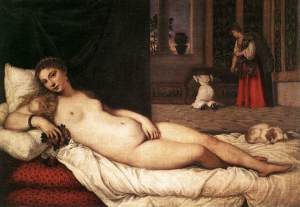I can remember when I first saw Manet’s Olympia and was told it had created a scandal. I had found it quite amusing that this one in particular should have, at the time it was painted, caused so much indignation when so many other paintings depicted women in –what I thought at the time– a very similar way.
Edouard Manet, Olympia, 1863
I find it relevant before looking at the painting itself, to put some ideas across. In his book Ways of Seeing (1972), John Berger talks about the difference between men and women (not so much as it is, but as it was conventionally seen).
“To be born a woman has been to be born, within an allotted and confined space, into the keeping of men. The social presence of women has developed as a result of the ingenuity in living under such tutelage within such a limited space. But it has been at the cost of a woman’s self being split into two. […] From earliest childhood she has been taught and persuaded to survey herself continually. And so she comes to consider the surveyor and the surveyed within her as the two constituents yet always distinct elements of her identity as a woman. She has to survey everything she is and everything she does because of how she appears to others, and ultimately […] to men, is of crucial importance for what is normally thought of as the success of her life”. I can’t help thinking of the Marquise de Merteuil in the book Les Liaisons dangereuses by Choderlos de Laclos (1782) and what happens to her when she “forgets” that.
Berger continues: “Men look at women. Women watch themselves being looked at. This determines not only most relations between men and women but also the relation of women to themselves. The surveyor of a woman in herself is male: the surveyed female. Thus she turns herself into an object – and most particularly an object of vision: a sight”.
Jean Auguste Dominique Ingres, La Grande Odalisque, 1814
This idea of “sight” brings us to the difference between the naked and the nude. John Berger uses the example of the naked portrait of one of Charles the Second’s mistresses and how it is a sign of her submission to the King. On the contrary, take La Vérité sortant du puits by Edouard Debat-Ponsan (1898) that I mentioned in my post “Félix Vallotton analysis” or Ingres’ La Grande Odalisque (1814) for example. Although they depict bare women, they are different. “To be naked is to be oneself. To be nude is to be seen naked by others and yet not recognized for oneself.” That is, as an object of vision. The women here are representations of an idea. They are sights.
Titian, Venus of Urbino, 1538
This finally leads us to Olympia. The controversy wasn’t caused by the fact of it being the painting of a nude, but rather by the fact it was a provocation, a mimicry of a nude. It was deemed indecent and vulgar because it was quite clear to people at the time that this was the painting of a contemporary. Olympia isn’t just a sight. She is a prostitute – the cat, notably a symbol of lust, has replaced the dog, symbol of fidelity, like in Titian’s Venus of Urbino (1538) by which Manet was inspired. Furthermore, she isn’t submissive at all. Her hand tightly covers her genitalia not so much because of a sense of modesty but to assert her independence. Independent also she is from her admirer whose bouquet she hardly acknowledges. And look at how she gazes almost with disdain to the viewer, putting him (almost all the viewers at that time would have been men) in the shoes of her next client. In other words, she does not represent an ideal but a perhaps harsh, unpleasant reality.
“I render the things that I see as simply as possible. So, Olympia, what could be more naïve? There’s harshness I am told. It was there, I saw it. I painted what I saw”


